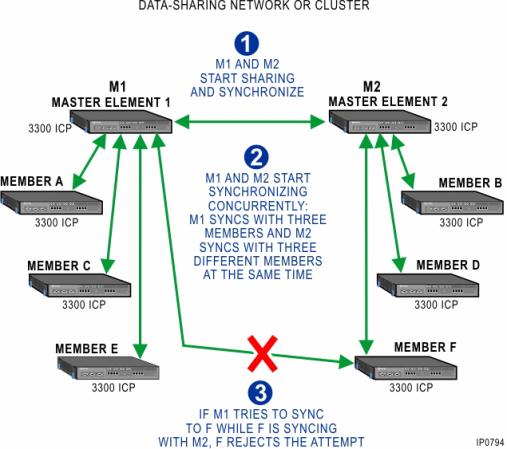
Performing concurrent synchronizations allows you to divide synchronization tasks between two or more administrators to create smaller workloads and reduce the amount of time required to synchronize the SDS elements. Each administrator can perform synchronizations from a different master element, which means that two or more synchronization processes can run concurrently. However, synchronizing network or cluster elements concurrently can result in the creation of distribution errors.
Consider the following conditions before performing a concurrent synchronization:
Your SDS community may consist of one or several "master" elements. See About SDS Element Relationships for a definition of the term "master" element.
You can run concurrent synchronizations from two or more different "master" elements to each of the other member elements within a network or cluster that is already sharing data.
During a synchronization, each element communicates with only one other element at a time. Each master element synchronizes consecutively one member element at a time.
During a synchronization, both the master and member element reject changes coming from other network elements. Rejected changes create distribution update errors on the master element.
Each member element rejects changes sent from other members or masters only for the duration of its synchronization with a master. When the master moves on to synchronize with another member, the synchronized element can begin receiving data as usual.
Use the Shared Data Updates form to manage failed distribution updates created by concurrent synchronizations. You can retry or delete any failed distribution updates after the synchronizations are complete.
For example, consider the following concurrent synchronization scenario in a network or cluster consisting of six network elements that are already sharing data through SDS:

Master 1 starts sharing and performs a synchronization with Master 2.
Next Master 1 initiates a synchronization with Members A, C, and E.
Meanwhile, Master 2, initiates a synchronization concurrently with Members B, D, and F.
Master 1's shared data updates are refused by both Master 2 and Member B, while they are engaged in a synchronization. Master 2 and Member B will generate distribution update errors on Member 1. Master 1 then goes on to synchronize with Members B, D, and F, which are not yet engaged in any synchronization process. Once Master 2 and Member B are in sync, they can begin receiving data as usual, and Master 1 can retry the synchronization attempts.
